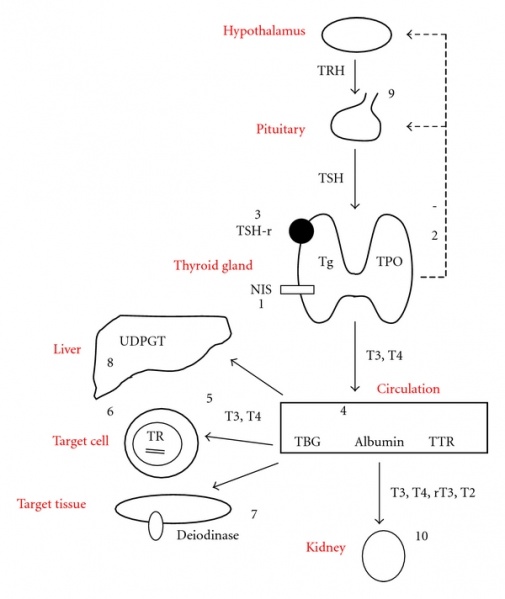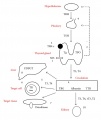File:Thyroid hormone homeostasis.jpg

Original file (600 × 712 pixels, file size: 80 KB, MIME type: image/jpeg)
Thyroid Hormone Homeostasis
| The complex mechanisms of regulation of thyroid hormone homeostasis and the possible mechanism of action of the thyroid disrupting chemicals.
The thyroid and the thyroid hormones, tri-iodothyronine (T3) and thyroxine (T4), participate with the hypothalamus, secreting thyrotropin releasing hormone (TRH), and pituitary, secreting thyrotropin (TSH) in a classical feedback controlled loop. Iodide is transported into the cell by the sodium-iodine symporter (NIS) and oxidized by thyroid peroxidase (TPO). TPO also catalyzes the iodination of thyrosine residues on thyroglobulin (Tg). All processes in the cell are stimulated by binding of TSH to the TSH receptor (TSH-R).
|
Possible mechanism of action of the thyroid disrupting chemicals
|
- Links: Thyroid Development
Reference
Hartoft-Nielsen ML, Boas M, Bliddal S, Rasmussen AK, Main K & Feldt-Rasmussen U. (2011). Do Thyroid Disrupting Chemicals Influence Foetal Development during Pregnancy?. J Thyroid Res , 2011, 342189. PMID: 21918727 DOI.
Copyright
© 2011 Marie-Louise Hartoft-Nielsen et al.
This is an open access article distributed under the Creative Commons Attribution License, which permits unrestricted use, distribution, and reproduction in any medium, provided the original work is properly cited.
Figure 1 JTR2011-342189.001.jpg http://www.ncbi.nlm.nih.gov/pmc/articles/PMC3170895/figure/fig1
Cite this page: Hill, M.A. (2024, April 24) Embryology Thyroid hormone homeostasis.jpg. Retrieved from https://embryology.med.unsw.edu.au/embryology/index.php/File:Thyroid_hormone_homeostasis.jpg
- © Dr Mark Hill 2024, UNSW Embryology ISBN: 978 0 7334 2609 4 - UNSW CRICOS Provider Code No. 00098G
File history
Click on a date/time to view the file as it appeared at that time.
| Date/Time | Thumbnail | Dimensions | User | Comment | |
|---|---|---|---|---|---|
| current | 00:06, 23 September 2011 |  | 600 × 712 (80 KB) | S8600021 (talk | contribs) | ==Thyroid Hormone Homeostasis== The complex mechanisms of regulation of thyroid hormone homeostasis and the possible mechanism of action of the thyroid disrupting chemicals. The thyroid and the thyroid hormones, tri-iodothyronine (T3) and thyroxine (T4), |
You cannot overwrite this file.
File usage
The following 2 pages use this file: